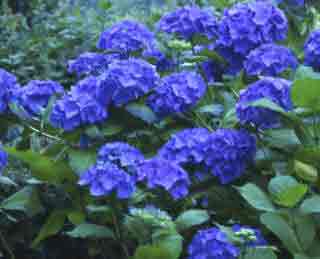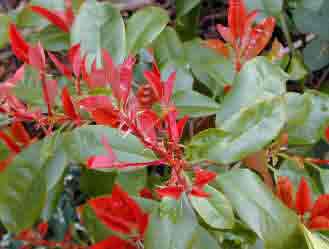Blue Flowering Hydrangeas | How to Do!
One of the most appealing and popular sights in a garden, is a mass of blue hydrangea flowers. No other plant offers such a bright blue for such a long time, than those Hydrangeas with either tight globes of blue flowers – the Mopheads – and the frilly Lacecaps. Both types will be members of the Hydrangea macrophylla group.
Unnecessary mystique surrounds the growing of Hydrangeas with blue flowers. The answer lies not in the name – Hydrangea Blue Wave; Bluebird; Blue bonnet, or Sky Blue. It is all about the soil type in which you grow your Hydrangeas. There are a few that have been specifically bred to be a better blue than normal pinks. But, for them to remain blue, they will require suitable Hydrangea soil conditions, or else Blue Wave, becomes “Pink Frills’ or whatever!
The exceptions being most of the white Hydrangeas whichever group they are in. A white, stays white or maybe cream regardless of the soil types. White Hydrangeas do not turn blue.
If you grow your ‘pink’ Hydrangeas in the ‘right’ type of soil, they will turn blue. If you grow your blue Hydrangeas in the wrong soil type, they will turn pink – or maybe insipid mauve.
 The
Right Soil Type
The
Right Soil Type
For Hydrangeas to remain, or turn blue, they have to be grown in an acid soil. If they are grown in an alkaline soil – one that has a high lime content – they will turn pink. So, if Rhododendrons grow well in your garden or surrounding area, the chances are that your soil will be either neutral or low ph.
(Ph is simply the scale that is used to measure the acidity or alkalinity of the soil.) Soils with a ph level of 6.5 are considered as being neutral. Above that, and the soil will be alkaline. Soils of ph 6.00 or 5.5 are considered as being acid. The lower the ph level the more acid the soil is; ph 5 is very acid and makes for good deep blue hydrangeas.
Hydrangea soils with a ph level of 6 – slightly acid – are touch and go as far as blue Hydrangeas are concerned. To be certain, you will need a Hydrangea soil ph level of less than ph 6; ph 5.5 or lower is best.
Testing Soil Ph
The easiest way - other than observation of what grows in your locality, it to take a small handful of soil from the area to be assessed; place it in a plastic container and drip some vinegar on it. Any trace of bubbles from the soil invariably means that lime is present. No bubbles and it is either neutral or below (acid).
A more sophisticated way - easy and inexpensive - it to buy a soil testing kit which will give you a better degree of accuracy together with how to rectify your soil ph level.
For Hydrangeas to have blue flowers, they need a supply of aluminium from the soil, and to a lesser degree the element iron. Both elements are present in most soils – but are locked up by chemical reaction in alkaline or high ph soils. The acid or lime soil is not a direct problem to the hydrangea; it is the effect such soils have on the free supply of aluminium – and iron.
It is relatively easy to lower the ph level in a localised area of the garden, simply by the addition of Sulphur in the short term and acid-reaction mulches in the longer term. Both will adjust your Hydrangea soil to a suitable level of acidity.
Individual Hydrangeas can be treated with a special hydrangea colourant, which basically lowers the ph in the area it is applied.
Other ways to acidifying your soil include applications of Ammonium Sulphate; Aluminium Sulphate; Organic mulches, or simply applying a soil acidifier. Any of these will allow the aluminium in the soil to be ‘released’ and absorbed by the Hydrangea.
 If
you live in a high alkaline area – such as the Kentish Downs, then
best to grow your Hydrangeas – if you want blue colours – in
containers, but be aware that the tap water may also be alkaline in
such areas!
If
you live in a high alkaline area – such as the Kentish Downs, then
best to grow your Hydrangeas – if you want blue colours – in
containers, but be aware that the tap water may also be alkaline in
such areas!
High ph soils also lock up the iron element in the soil, which does not basically affect the flower colour, but will lead to lime-induced chlorosis. This is seen as the yellowing of foliage - sometimes leading to the death of the plant unless rectified.
So, Blue or Pink Hydrangeas from the Hydrangea macrophylla group - which are typified by either mophead or lacecap style blooms. Either will reward you if you get the soil right. If not, then enjoy the pink colours. White flowered Hydrangeas do not change to blue, though they might take on a slight pink tinge at the end of the growing season!
Lacecap and Mophead Hydrangeas | Pruning Hydrangeas | Garden Soils |
Best Selling Gardening Products
Popular Gardening Sections

Problems
Identify Weeds in The Garden - How to deal with weeds. Diseases and Pest which harm your garden and plants, learn how to prevent, deter and erradicate your garden problems.
Garden Problems
Pruning
Pruning Guide. Shrubs flower better with correct pruning. Many illustrations and examples of what to do - and when. Includes evergreens, roses, flowering shrubs, spring flowering shrubs and pruning for stem effect. This is our most viewed and comprehensive section,
Pruning
Gardening Businesses
Gardening Businesses listed in the UK counties and USA states. County and State Listings of businesses involved in Garden supplies and services. If you wish to be added to the Directory, please send us your information. Having problems, use the search box
Businesses
Gardening
In this section you will learn about Gardening Basics, Containers, Landscaping, Propagation and Soil.
Gardening
Gardening Gifts
Gardening Gifts and Reviews, Read Before you Buy
- Gardening Gifts Ideas
- Gifts For Her
- Gifts For Men
- Power Tool Gifts
- Cheap Gifts
- Personalised Gifts
- Wildlife Gifts
- Family Gifts



